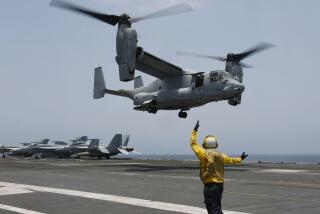Justify Harrier or Drop It
- Share via
In the more than three decades that Marine pilots have flown the Harrier attack jet, it has wowed air show crowds and movie audiences with its vertical takeoffs and quick maneuvers, combining the moves of helicopters and fixed-wing planes. But the vaunted vertical takeoff has not been used in combat, and the razzle-dazzle has overshadowed the plane’s abysmal safety record.
The AV-8A Harrier and its successor, the AV-8B, have been in 143 major noncombat accidents, killing 45 Marines. The crashes have destroyed one-third of the Harrier fleet. The planes were chronically plagued with serious problems in their engines, wing flaps and mechanical systems. This week, the House Armed Services Committee announced hearings on the safety of the Harrier and other military aircraft in response to The Times’ four-part series on the plane last month (www.latimes.com/news/specials /harrier). Those hearings are overdue.
The Harrier’s mission is to quickly get close to troops on the ground and support them with firepower. But since 1971, when the Marines bought the aircraft and billed it as able to take off from tiny patches of ground or damaged runways in remote areas and roar to the rescue of besieged troops, the U.S. military’s use of air power has changed.
In the Persian Gulf War, U.S. air commanders could “stack” many aircraft over a battlefield and quickly and efficiently call in strikes as necessary; this diminished the need to base planes close to the troops, a Harrier advantage. When the Harrier did fly in that conflict, its loss rate was more than double other major U.S. combat jets.
In Afghanistan, commanders held the Harriers out of the first weeks of combat. Marines said two AV-8Bs sent to a partly destroyed airstrip in Kandahar showed the capability of operating where other planes could not. But the two stayed only one night, flew four sorties and dropped no bombs. A Marine pilot who flew Harriers in Afghanistan said the flights from Kandahar “were like photo ops.”
The Navy, which pays for Marine aviation, has spent nearly $9 billion since 1971 to buy and modify Harriers. It has spent $4.1 billion more since 1986 to repair and fly the plane. Now the Marines are rebuilding 74 Harriers at a cost of $28.2 million each. That heavy price tag -- which pales in comparison with the loss of 44 Marine pilots and a flight surgeon -- should prompt Congress to ask why the Harrier should be kept flying at all. The Marines have it scheduled to fly an additional 13 to 17 years. The post-World War II notion that Marines in the air are needed to protect Marines on the ground, with their own special planes, also demands reexamination. Navy and Air Force pilots can support Marines on the ground.
Military aviation is hazardous, especially in testing new aircraft. But The Times’ series, by Alan C. Miller and Kevin Sack, showed that the Marines rushed the Harrier into the fleet and then dawdled in fixing its problems. The Marines have made the same mistakes with the V-22 tilt-rotor Osprey aircraft they are testing and which is supposed to speed troops into combat. Two Osprey crashes in 2000 killed 23 Marines.
Congress has held hearings on Harrier crashes before. The House Armed Services Committee’s inquiry this time should not accept the Marines’ usual explanation that the problems have been fixed. Instead, Congress should ask the Marine Corps to explain and justify its mission for the Harrier. If it cannot do so persuasively, there is no reason why Marines should not fly planes with better safety records. In more than three decades, the Harrier’s ability to take off vertically has never been used in combat by the Marines -- although the craft was used to save Miami in the 1994 Arnold Schwarzenegger movie “True Lies.” Based on the Harrier’s safety record, fantasyland is where it belongs.
More to Read
Sign up for Essential California
The most important California stories and recommendations in your inbox every morning.
You may occasionally receive promotional content from the Los Angeles Times.













